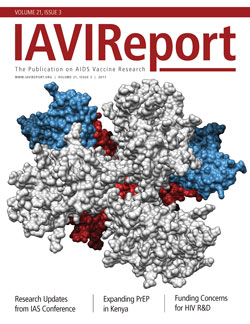IAVI REPORT – VOL. 21, NO. 3, 2017
 It is September again in New York City, which ushers in Autumn, sends kids back to school, and brings the United Nations (UN) General Assembly to the city for its annual meeting. Most of the HIV/AIDS-related stories coming out of last week’s UN session touted significant progress in HIV/AIDS treatment.
It is September again in New York City, which ushers in Autumn, sends kids back to school, and brings the United Nations (UN) General Assembly to the city for its annual meeting. Most of the HIV/AIDS-related stories coming out of last week’s UN session touted significant progress in HIV/AIDS treatment.
As of 2016 there are 36.7 million people worldwide living with HIV. Roughly half of them are now receiving life-saving antiretroviral therapy. A major achievement to say the least, and newer and better drug options will now be available in many of the countries hardest hit by HIV/AIDS. There was an announcement during the UN assembly that two Indian companies will make the fixed-dose antiretroviral combination of three drugs (tenofovir disoproxil fumarate, lamivudine, and the newer drug dolutegravir, a combo known as TLD) available in 92 poor countries for only about US$75 per person a year. This will bring a newer first-line therapy to many more in need and may help alleviate the growing problem of drug-resistant virus that renders treatment ineffective.
But scientists, funders, and HIV prevention advocates who gathered at the New York Academy of Sciences on September 22, just after the meetings finished, warned that this progress, while significant, is incomplete and fragile. There were still 1.8 million people newly infected with HIV last year, which is why HIV prevention remains paramount. Newer and better HIV prevention options, particularly those that are longer acting, are still sorely needed.
At the same time, efforts to increase access to existing prevention strategies such as oral pre-exposure prophylaxis are underway. In this issue we feature a story about Kenya’s valiant efforts to scale up PrEP access within the country’s most at-risk populations. We also detail the latest research presented at the International AIDS Society’s conference this summer, and talk with IAVI scientist Devin Sok about his research in HIV and beyond.
Development of any new prevention options is, of course, dependent on continued funding, which is by no means a guarantee these days as governments struggle with competing priorities. Spending for HIV research and development seems to be on everyone’s minds. Some worry that success in rolling back HIV rates and expanding access to treatment may come at a cost. Mitchell Warren, executive director of the HIV prevention advocacy group AVAC, states it best: “These are great times but we shouldn’t overstate success because the minute we do, funding dries up.”
—Kristen Jill Kresge


